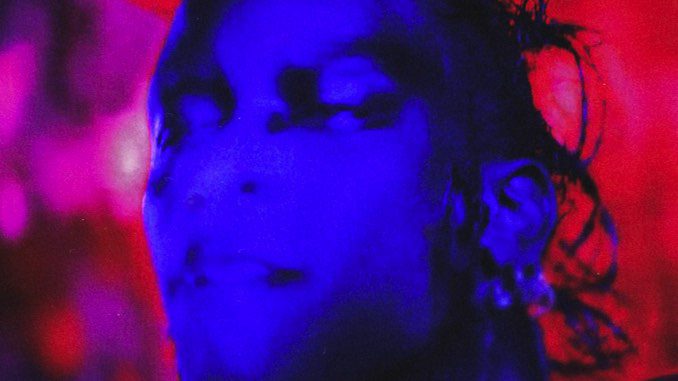Björk Guðmundsdóttir, better known mononymously as Björk, is a big deal. She has been for quite some time. Ever since rising to reluctant national fame as a child singer in 1977 with a sweet little record of originals and covers called Björk, the talented vocalist has known some level of fame. The national notoriety she encountered at the tender age of 11 soured her on becoming a full-time recording soloist, but her affinity for music never waned. She spent her childhood and adolescence at Reykjavik’s Barnamúsíkskóli, a progressive music school that exposed her to both the traditional western classical canon and blossoming avant-garde traditions. The curriculum included the works of experimentalists like John Cage, exposing the young Björk and her peers to alternative definitions of music and inviting the students to explore new sonic terrains. The dissemination of punk throughout Iceland in the late 1970s and early 1980s exposed her to not only a new sound, but also a DIY mindset that Björk cites as essential to her lifestyle as a young artist. She punctuated her late teens and early twenties in a variety of Icelandic projects, like Spit and Snot, Exodus and experimental punkers Tappi Tikarrass.
Two of her next projects turned out to be her biggest: In the mid-80s, Björk fronted KUKL, a gothic post-punk band with clear London influences who developed a cult following, and The Sugarcubes, an internationally acclaimed touring band synthesizing avant-rock, dream pop and more across three albums before disbanding in the early 1990s. These experiences brought Björk a new notoriety in the worlds of DIY and alternative music where she could flourish, inspiring her to return to her cache of diaries and self-penned songs to claim a voice fully her own.
That voice surprised and delighted audiences with Debut in July 1993. Listeners did not know what to do with this album-suddenly, the ambassador of Icelandic rock had pivoted toward house, ambient, art-pop and other left-of-center electronic impulses. While some critics lamented this perceived loss, the greater critical base embraced this new Björk, and audiences flocked to her enigmatic voice and esoteric instrumentals. Almost 30 years later, Björk is back with a new studio album, Fossora, a bass-heavy, fungus-inspired 13-track behemoth that shows how she continues to surprise after decades of sonic experiments that have rendered her an icon and a legend.
To celebrate the momentous achievement that is her 10th album, it bears looking back on Björk’s colorful career and examining how her studio LPs stack up against each other after all these years.
10. Volta (2007)
2007’s Volta is full of genuine surprises, including some of her most memorable. More confrontational than her preceding 21st-century albums, 2001’s Vespertine and 2004’s Medulla, but also dialed back in seriousness, Volta remains Björk’s only record to reach the top 10 on the Billboard 200, peaking at number 9 on its May 26 release date, and lead single “Earth Intruders’’ slid into the Hot 100 in the week following its launch. Preeminently lauded as Björk’s most “commercial” release, the album is still undeniably Björk: A broad palette of electronic genres and global influences still coalesce into a record with dazzling, puzzling soundscapes.
But the introduction of Timbaland and protégé Danja offered familiar faces in the rollout that piqued the attention of audiences, alongside further collaboration with the quiet legend Mark Bell. Timbaland’s knack for instilling avant-garde sounds into number-one hits made him feel like a natural fit for an artist in as unique a position as Björk. As a team, Björk, Timbaland and Danja launched “Earth Intruders” and “Innocence,” each representing distinct gestures in each other’s toolboxes, interwoven with confrontational beats: Where “Earth Intruders” offers percussive worldbeat and opens Volta with an accusatory thesis, “Innocence” provides a thumping experimental-pop experience that requires some vigorous dancing.
The liberal use of brass throughout the record is memorable. Björk deliberately recruited an ensemble of 14 Icelandic women to perform the horns on Volta, extending her commitment to feminist approaches to recording. On “Pneumonia,” in particular, the horn section offers full-bodied support for Björk’s gentle, hovering vocals. “Declare Independence” offers ingenious use of brass for one of Björk’s oft-revisited political anthems, but they come from samples from a previous soundtrack album.
Worldbeat, in particular, feels like a genre designed for Björk, whose solo career has been dedicated to the intentional repackaging of stylings and practices from all over the world. However, “Earth Intruders” sounds like the best version of a Tune-Yards song, somehow full of global context and divorced from those same geographies. Global fusion genres are exciting, but too much excitement can obfuscate meaningful references. The song has, however, remained quite popular.
9. Biophilia (2011)
In October of 2011, just as Iceland was beginning to recover from an intense financial crisis, Björk released Biophilia, a multimodal project complete with a 10-track album and an educational app centering musicology. On the album, Björk maps out the intersection of nature and technology in art explicitly—these juxtaposing curiosities have been key to much of her discography, but on this “app album,” she is addressing the conflicts head-on, rather than imbuing her music with concern for nature. The resultant project is one of Björk’s subtlest works.
To an extent, this subtlety presented a challenge for critics who had gotten to know (and, in many cases, love) the Volta Björk. As rife with beauty as songs like “Hollow” or lead single “Cosmogony” are, they are quite sparse compared to Volta or even Debut. “Cosmogony” possesses a gentle dynamism and fascinating choral parts, but even when it gets loud, it remains soft in rhythm, and uncharacteristically predictable. It is, however, staggering in beauty. Björk’s voice flutters above an at-times unsettling electronic arrangement (“Dark Matter”) and harps pluck soft, memorable melodies (“Moon”). The sparsity itself presents opportunities to rest and breathe, just as a clearing might in a forest for the communities of animals and travelers Björk includes in her landscapes.
One has to wonder if the sparsity may also have been a practical measure for a multimedia concept album. Just as essential to the music is the user experience of the accompanying applications and their pedagogy. It begs the question: Did the app and its mission reduce the scope of Biophilia musically?
Whether the album “suffered” from the burden it presented, the app itself achieved permanence in the collection of the Museum of Modern Art. While it is hard to find even dedicated Björk fans who have kept the app (which is still available on the App Store for $12.99), the album it accompanied remains a key milestone in the artist’s career.
8. Utopia (2017)
2017’s Utopia is by no means a collection of songs about a literal Garden of Eden-style place: The emotional landscape through which she navigates is quite fraught. It lacks the fiery intensity of 2015’s Vulnicura, but the nebulous, hard-to-pinpoint terrains reflect paradise through environmental and related political prisms that challenge traditional visions of utopia. Initial press highlighted Björk’s semi-serious statement that Utopia would be her “Tinder album,” suggesting that it navigated Björk’s nascent dating life, but the remark better reflects the transition between her previous breakup-centered record and this new one.
In collaboration with Venezuelan electronic prodigy Arca, Utopia connects neoclassical folk, electronica and avant-pop into an ambitious gallery of soundscapes. Over 70 minutes, Björk’s matches her vocals to some of her most challenging, cinematic music to date. The nearly 10-minute “Body Memory” is a particular standout, juxtaposing industrial, flute and choral accompaniment as the intricate organic-meets-mechanical foundation for Björk’s unpredictable vocals. While industrial music had a place in Björk’s discography for a long time prior, Arca’s signature sounds are especially audible in “Body Memory,” “Losss,” “Arisen My Senses” and more. The intense sensory experience Arca’s production offers amidst classical instruments, interwoven with Björk’s gentle voice, is key to the Utopia experience.
Intermixed with these intense techno-folktronica experiments are highly moving, exhortative classical exercises. “Tabula Rasa” fits this bill precisely: Between the droning choir of flutists and oscillating vocals, the song is downright hypnotic. It is also an optimistic call for the next generations to change the world for the better, even as she apologizes for her generation’s wanton destruction.
As appealing as these soundscapes are, their grand sprawl and atypical melodies can make the album a challenging casual listen. Each movement possesses largesse beyond the vast majority of Björk’s discography. And yet, a hook is rarely found, largely to the album’s artistic merit, but not entirely without its drawbacks.
7. Medúlla (2004)
After a smattering of studio albums in the electronic sphere, Björk worked an unexpected angle on her 2004 album Medúlla: the human voice. Medúlla, save for a few synthesizers and some programming, is entirely a cappella. To add dimension beyond Björk’s already dynamic voice, she surrounded herself with vocalists lending everything from choral accompaniment to beatboxing to Inuit throat singing. The resulting record proved confounding and sensational, and forced listeners to focus on Björk’s spectral voice above all else.
Medúlla enters somewhat gently, initially with harmonizing tracks of Björk’s “ooo”s while world-famous Inuk throat singer Tanya Tagaq enters with her signature style of solo performance. For the record, Björk preferred to guide her writing with instinct, singing about what was enveloping her mind at the moment in the studio. “Pleasure Is All Mine,” for example, was written shortly after Björk gave birth to her youngest child and covers her experience nursing—a subject at the forefront of her mind that is often avoided in polite company. “Where Is The Line” acutely confronts Björk’s younger brother, with whom she was in another complex disagreement.
Beatboxing from legendary beatboxer Rahzel adds a percussive element to “Where is the Line” that underscores the pugnacity in the lyrics. The beatboxing is even more pronounced on “Who Is It,” a particularly exuberant track again mapping mother-child dynamics. Beatboxing from both Rahzel and Japan’s Dokaka immediately draw the listener in on “Triumph of a Heart,” which also features the “human trombone” stylings of Gregory Purnhagen. “Triumph of a Heart” is frenetic-if the initial hook fails to draw a listener in, nothing else in the song will. But once hooked, the song is danceable, bubbly and pleasantly weird.
Medúlla is full of surprises, some clearly inspiring the works of later experimentalists who manipulate the voice. At moments, one can hear tracks that might predict Grimes or SOPHIE in their innovative use of vocals. There are undoubtedly limits to what can be accomplished with the voice, but what Björk accomplishes on the record ought to reframe the artistic potential of a cappella. It’s more than just what they do on Glee.
6. Vulnicura (2015)
Björk had settled into a new mode of working and arranging by the time Vulnicura was being dreamed up. The instruments that took precedence on Biophilia, strings especially, articulated a mode of musical communication that resonated with her and would continue to, especially from a process standpoint, after her tumultuous breakup with contemporary artist Matthew Barney, with whom she had her youngest child. The string arrangements consumed much of her headspace, proving a practical distraction from her heartbreak. The resultant string parts are so dazzling that she released a companion album of Vulnicura tracks minus beats, Vulnicura Strings.
Just as dazzling as the string arrangements are the vocals, where Björk deploys a simplicity and directness uncharacteristic of many of her prior albums. On “Stonemilker,” Björk addresses longing for that kind of comprehensive ease, declaring: “Moments of clarity are so rare / I better document this.” Each song is a testimony to a love on trial, a love cross-examined, under the linguistic clarity towards which one gestures in tragedy when words are scarce.
As profound as the strings are on Vulnicura, the beats provide brilliant augmentation. For the electronics, Björk collaborated primarily with Arca, whose own forays into avant-pop exhibit an intensity and personality not unlike Björk’s. On “Black Lake” especially, the electronic and string arrangements complement each other beautifully in what can only be described as a Björk “diss track,” a 10-minute excursion into the feminine rage that only she can translate. The strings and beats swell with the mood, reaching moments of discord, then returning to spaces of harmony as Björk works through her own vulnerable fury.
As similar in instrumentation as Vulnicura is to Biophilia, the emotional and sensory journeys on the former outstrip the latter by leaps and bounds, painting Biophilia as an almost sterile intellectual exercise. Critics have drawn a convincing parallel between Vulnicura and Vespertine, another record where subtleties speak volumes. Vulnicura is an enduring Björk record in part because the narrative, an awfully public disintegration of a decade-long partnership, is so devastatingly compelling to watch, but Björk’s nuanced, at times fiery, recounting of the experience from her vantage point is a breakup album providing layers upon layers of devastation.
5. Fossora (2022)
Since Medúlla especially, Björk’s studio albums have had a focal point—an instrument, a thought experiment, an event—that have given each record a discernable “era.” Whether the focal point is divorce, voices or apps, Björk’s later discography has offered landmarks that can help fans and historians arrange and recall her chronology. For Fossora, Björk uplifts the mushroom: a fascinating family of life forms whose curious shapes, behaviors and networks have inspired varying levels of awe. Björk developed a fascination with mushrooms and their symbolism in recent years—after all, is there not something wildly fascinating about organisms who proliferate on planes where organic plant life is dying?
Clarinets also caught Björk’s attention and never let go. B-flat and bass clarinets join forces in sextet form, especially, throughout the album, beginning on “Atopos,” Fossora’s lead single. As the clarinets meander, a hefty reggaetón beat unfolds. At some level, the clarinets feel silly and beautifully unwieldy next to this beat, not just out of place in time, but also out of place in style. When asked which instruments are “sexy,” does the clarinet come to mind? Unlikely. But their presence is deliberate and well-executed. On “Victimhood,” a track Björk composed amidst a personal fixation on Jungian archetypes, the clarinets reveal themselves immediately, with depth, intensity and rhythmic creativity that is, in typical Björk fashion, impossible to predict. Here especially, the bass clarinets work in brilliant tandem with the beats to make waves that undulate beneath this final divorce anthem Björk has left to present.
In the interim period between Utopia and Fossora, Björk lost her mother. For much of her adult life, Björk has avoided memorials and mortality, but confronted with the loss of a monumental figure, Björk felt a pull to eulogize her mother in opposition to patriarchy, recognizing the example of a feminist life that she saw in her mother. “Sorrowful Soil” could have been recorded in a grand sanctuary; the choral arrangement is as arresting as the distinctive flying buttresses and stained glass of a Gothic cathedral. The subsequent devotional-folk masterwork, “Ancestress,” offers fluidity and freedom for grief to take hold for a less lugubrious, more towering manifestation of mourning. In Björk’s experience, formal mourning is too patriarchal, stunting emotion. On “Ancestress,” Björk sought a matriarchal experience, unburdening her from the strictures of a linear grief narrative. She exemplifies what is not only possible, but also necessary in her mourning.
Björk’s appreciation for, and deliberate incorporation of, the latest and greatest of global electronic music is on full display with Fossora. When “Atopos” dropped, fans across the globe expressed surprise to hear the wildly popular beat style make the cut (leading to some funny tweets), but Björk also found herself entranced by Indonesian gabber, epitomized by dance-punk outfit Gabber Modus Operandi. The fusion of traditional and futuristic sounds in gabber works not unlike Björk’s frequent efforts to juxtapose Icelandic folk patterns with electronic beats. Features from serpentwithfeet and Björk’s own children are also album highlights. Unsurprisingly, Fossora is at times inscrutable, but above all, the record is full of delightful surprises, teasing out the limitless possibilities of experimental pop.
4. Debut (1993)
Debut is, without a doubt, a standout Björk record, both for its beauty as a project, and for its treatise on popular experimentalism and pop music that would become the bedrock of Björk’s multi-decade career. It cannot be understated how confused many critics were to discover that 1993’s Debut collected the music bouncing around Björk’s head, at a time when Björk was best understood as Iceland’s alt-rock and punk envoy. The eclectic influences of jazz, ambient, house and dance music collaborated with a global cache of instruments, bound by a cover featuring the young art-pop star in muted sepia. But as Björk notes of the 1990s media landscape on the podcast Sonic Symbolism, music newsrooms were small, overwhelmingly male and disastrously under-informed on the rapidly globalizing electronic music scene, which inspired Björk intensely upon her arrival to the United Kingdom after her departure from The Sugarcubes.
For Debut, Björk revisited her diaries and expanding folder of songs she penned, particularly as a young girl, but never had an outlet through which to express them. In addition to the electronica notes that give pep on the record, Björk incorporated global influences and instruments onto Debut, especially on “Venus as a Boy.” A cadre of tablas, or twin handheld membranophones, comprise the iconic rhythm section that imbues the song with a fluid sensation. Incorporating global influences is a deliberate project for Björk, who has often felt prejudged or pigeonholed for her Icelandic heritage, owing to Iceland’s liminal position in a materially and powerfully polarizing global landscape. For “Venus as a Boy,” the Indian influence confounded critics just as the electronics did, but Debut resonated with audiences, and in some places (including the States), the record remains her best seller.
Björk also identifies, in Debut and her musical endeavors at large, a feminine energy with which she wants to cloak her records. Identifying traditional rhythmic structures in musical movements ranging from classical to contemporary pop with patriarchal limits, Björk seeks to craft rhythm and melody with more room for unpredictability. On tracks like “One Day” and “Human Behaviour,” it can be demonstrably hard to get hooked the way one might with a traditional pop arrangement, but Björk still displays an appealing range of emotions, from the demure to the outspoken, in waves and arrangements that feel more human than those of a meticulously manufactured pop song. That connection to her emotion is not a primitivist response, e.g. “returning” to some original emotionality, but rather a forward move that rejects hierarchies of sensemaking practices that privilege reason at the expense of others.
3. Homogenic (1997)
By 1997, the tribulations of international fame had caught up to Björk. The corporeal dangers of stalkers and the discursive violence of stereotype had come to weigh on the artist with a vengeance. After the jubilee-laden statement of Post, Björk had a record to set straight with her audience, as well as herself, the person who had uprooted her life to become the publicly visible diplomat to the electronic vanguard she never anticipated becoming. In an Andalusian studio, Björk engaged herself in dialogue about self and home, and Homogenic burst forth. She identifies Homogenic as a “patriotic” album, which can be hard to detect at first. But as Björk explores Iceland’s past, its future, its landscapes, its choral traditions and its romanticism, the laudatory components of the record are hard to miss, particularly in its musicality.
Working with a romantic octet in tracks that deploy parallel fifths with nearly reckless abandon across some of the most intense beats she would ever produce, Björk lays bare love of a country often minimized as a semi-primitive utopia. While many of the tracks contain references to failed relationships, only a select few—most notably “5 Years”—see romantic love and separation as central themes. Album opener “Hunter” is one track that appears to make a momentary citation towards a breakup anthem, but Björk herself asserts the lyrics pertain more to occupational strife as a working musician. What connects these songs, as well as the rest of Homogenic, are the expressive strings, references to Icelandic thought and those iconic, unsettling fifths rarely found outside of Icelandic music.
Homogenic is the first record where Björk worked with Mark Bell, the legendary DJ and producer with whom she maintained a particularly tight working relationship. Between his beats, which would become legend, and the grand string octet, the juxtaposition between traditional and futuristic is uncannily balanced. Björk, Bell and their fellow collaborators constructed hundreds of beats for the record based on desired motifs, especially volcanoes, that worked like interchangeable parts for the individual songs. Atop that volcanic foundation, Björk uttered some of her most breathtaking lines. On “Bachelorette,” the Post character Isobel returns to the city via train, and Björk opens with the almost absurd line, “I am a fountain of blood / In the shape of a girl.” Björk could barely bring herself to pen these dramatic lyrics herself, and found encouragement and brilliance in fellow Icelandic wordsmith Sjón, who also helped contribute lyrics to lead single “Jóga,” a song heavily borrowing from staple Icelandic musical structures.. While the record is decidedly Icelandic, Björk went global for her album cover, portraying herself as a futuristic tarot figure combining visual signifiers originating from every continent. It’s the embodiment of reverse “glocalization:” Björk tailoring herself to accommodate worldwide accouterments for everyone else’s consumption.
Homogenic’s influence today is unquantifiable. Few records have attracted the critical praise that Homogenic has, even if the record defies casual listening for even Björk’s most intense devotees. Already well-respected as a producer, Bell achieved a level of immortality for his productive prowess, particularly on the 808 machine, breathing new life into the storied drum machine. As a work of art, Homogenic is genuinely hard to stomach. It is a very difficult album. But the spectacles that her words and the instruments project are even harder to ignore, and impossible to reject.
2. Vespertine (2001)
In 1999, Björk got a laptop. After years straight on the road, and after recording Homogenic in Spain for her own security and to produce a yearning for home, Björk welcomed the ability to record and edit music from the comfort of her own home. Basing production out of her home also allowed Björk to record on her own schedule and suss out how she felt each day, never pushing herself to write, record or edit in a moment where she felt herself to be in an inappropriate headspace. It is a much more accommodating method of recording and production than traditional studio excursions, where reservations can be expensive and hard to come by, making every moment not spent using the space and equipment costly. Björk reveled in the ability to record on her own schedule, especially after being away from home and family for extended periods during which she toured the globe, performing for thousands upon thousands.
For Vespertine, Björk complemented her domestic recording process with more reserved compositions. While Post revealed Björk’s effervescence and Homogenic proved she has a bombastic side, Vespertine uses a suite of microbeats and softer instrumentals to achieve a more interior sound. She sought to create these songs to show that softer side she possesses, but she also arranged her songs with selected instruments (e.g., harps, music boxes) because of how they sound in older laptop speakers. “Frosti” is explicitly a track made from a music box recording—one that Björk composed and commissioned herself. The delicate, sonorous rhythms suit her technological apparatus well, and continue to inspire even as audio tech has improved.
“It’s Not Up to You” is Björk’s finest example of pop. The microbeat foundation offers a consistent, toe-tapping beat with nodes of intrigue while strings, harps and choir oscillate in timbre between Björk’s winding verses and her crashing chorus. “Pagan Poetry” displays an eroticism in its thumping beats and drawn-out vocals, complemented well by an icy music box arrangement and luminous harps. “It’s Not Up to You” and “Pagan Poetry” both exude unbelievable power despite their relative quietude, proving that what Björk showcased on Homogenic in terms of fortitude could be presented differently. Where Homogenic is explosive, Vespertine implodes, obliterating internal boundaries.
Vespertine is a frequent fan favorite. Björk’s lush vocals, romantic instrumentation and deeply personal, affective themes are strongly relatable and immediately resonant. Finding beauty in the minutiae and crafting a music landscape that celebrates the infinitesimal is tough to achieve—broad gestures are the most obvious way to guide a listener to the intended aesthetic and lyrical message. But Björk’s mastery of subtlety is a crowning achievement that Vespertine displays across each track.
1. Post (1995)
When Björk moved to London and immersed herself totally in the British electronic music scene, she uncovered a new source of energy within herself. Rave spaces and dance clubs brought something out of Björk that no setting on Iceland had managed to extract. In those early years of Björk’s solo music career and explorations into electronica, she exuded effervescence. She bubbled with the excitement of a freshly uncorked bottle of Dom Perignon. She poured that bubbly energy, with the diverse creative impulses she’d nursed since childhood, into her second album, Post, an eclectic art-pop experiment that called upon the hot ‘90s dance community to match her energy levels.
The catchy, kooky creativity that has come to define the Björk aural universe hits listeners with full force as soon as the record opens with “Army of Me,” an industrial track level-headedly but intently addressed to her younger brother. The more understated, but propulsive electronica hit “Hyperballad” follows, attracting intrigue as Björk’s rhythmic, hypnotic vocals recount a harrowing dream before gently erupting into a dance-inducing chorus. Björk’s love for electronic sounds, some heavy and some weightless, is on total display, informing the timbres she chooses for her incredibly powerful voice.
Also nestled in the first half of the album is an oft-discussed, seemingly random cover of Betty Hutton’s big-band jazz hit “It’s Oh So Quiet.” What does a 1951 Hollywood hit have to do with Björk’s love for the London life she’d just adopted? On her previous tour, the song came up randomly on tour and became a source of fascination for her and her touring party. The concept of Björk covering this track felt initially incompatible, but somehow worth a try. The result is captivating and does ample justice to the original, not least because Before revering the avant-garde or any other stylistic vanguard, Björk plainly loves music, having cultivated a wide appreciation in her youth that instilled a lifelong curiosity that continues to inform her artistic practice.
Björk’s broad interest in classical instrumentation continues in the latter half of the album right alongside electronic elements, especially on the epic “Isobel.” Orchestral strings are balanced in their romanticism with the psychedelic sensations of downtempo, grounding the track in an old-meets-new arrangement that has similarly come to define Björk’s sound. As bold as Björk’s songwriting gets on Post, she also dials it back when called for, especially on ambient ballad “Possibly Maybe,” an addicting, bewildering breakup song offering sensuality and melancholia in one, convincingly charting the conflicting emotions of a romantic dissolution. “I Miss You” dabbles in worldbeat with a subtlety and instrumental arrangement that effectively situates the geographic influences while offering a novel, stern foundation upon which Björk can build her dream man.
Across the baroque and futuristic components on Post, Björk is at her absolute best. Like many Björk albums, there is arguably not one bad song, but on Post, the dimension with which she approaches each emotion, free from the strictures of concept, with an expanding palette of influences, feels so revolutionary. Even when Björk is toying with sounds borrowed from centuries prior, it all feels brand new. Post is exciting, disorienting, dazzling. It is a treasure map through which Björk lays out the present and future of her music career. Musical and topical motifs that manifest on each subsequent Björk record appear here: the intoxicating liberation of dance, the guts required to confront masculinism, the organic chaos offered through blending the contemporary and traditional. All are present, and executed with striking perfection. Post is Björk at her biggest and best.
Devon Chodzin is a critic and urban planner with bylines at Slumber Mag, Merry-Go-Round and Post-Trash. He is currently a student in Philadelphia. He lives on Twitter @bigugly




